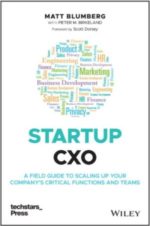Counter Cliché: And Founders, Too
Counter Cliché: And Founders, Too
This week, Fred’s chiche is that "the success of a company is in inverse proportion to the number of venture capitalists on the board".
I’d argue that the same statement is true of founders or management.
Boards help govern the company and watch out for shareholder interests. Boards give outside perspectives and strategic advice to the company’s leadership. Boards hire and fire the CEO. And — more and more every day with large public companies — boards keep management honest. How can these critical functions occur when a Board has too many members of the management team on it? They can’t. We’ve had outside directors at Return Path from Day 1.
I’m not advocating that Boards meet 100% apart from senior management. On the contrary, our most productive Board meetings at Return Path are the ones where we have lots of management participation. But execs present and discuss — and don’t vote — and they generally leave the last 30-60 minutes of every meeting for just the Board to discuss issues in private. I’m also not advocating that CEOs don’t sit on boards or that the CEO never hold the Chairman role. I think both of those items are critical to unify the watchdog function of looking out for all company stakeholders — shareholders, employees, and customers — at the highest level.
But while the success of a company may well be in inverse proportion to the number of venture capitalists on the board, that same success is jeopardized by too many execs, too.
9/11 Redux: Deja Senti
9/11 Redux: Deja Senti
I’m not sure if Deja Senti is a real phrase in French, but it should be. It’s at least the grammatical, if not idiomatic equivalent of Deja Vu, but for smells (literally “already smelled”).
That’s what it felt like coming home to Tribeca last night, after yesterday’s horrendous fire that destroyed seven abandoned warehouses in Greenpoint, Brooklyn, right across the East River from downtown.
It smelled just like it did on 9/11 and for three months afterward while Ground Zero’s rubble and oil tanks were still smoldering and spewing out a constant acrid smell across downtown. There are some kinds of Deja Senti that are quite pleasant — baking bread, campfires, fresh cut grass, even Elmer’s glue for some, but last night’s Deja Senti was just nauseating.
Thank goodness it’s mostly gone this morning — and even more so, thank goodness the “powers that be” have finally gotten their act together to really rebuild the World Trade Center. I can’t wait to see the Freedom Tower’s skeleton go up from our living room window this summer!
Doing Well By Doing Good, Part III
Doing Well By Doing Good, Part III
In Part I of this series, I blogged about my friend Raj Vinnakota and his amazing adventure starting the SEED School and Foundation in Washington, D.C. In Part II, I extended the conversation to some of the things we do at Return Path to help make the world a better place — even though our business model is less “inherently virtuous” than that of many other organizations, particularly non-profits.
One thing we did last fall in the wake of the hurricane devastation on the Gulf Coast was pledge to send one or two groups down to New Orleans with Habitat for Humanity to assist in the recovery and reconstruction efforts, giving people the week of paid time off and covering a portion of their travel expenses. We have six member of the company down there right now.
My colleague Tom Bartel is blogging about the experience every day this week, so far posted here, here, and here. (And if I had to guess, since this posting will live on the web long after today, I’d say his postings for the next two days will be here and here.) It’s an amazing story, a grim reminder of both how much damage there is AND how little has been done so far in more than six months since Katrina, and Tom chronicles it well.
I’m incredibly proud of our whole team down there — Tom, Stephanie Miller, Dan Deneweth, Melinda Plemel, Jeremy McGuire, and Harry Pallick (apparently the group’s Tool Captain — who knew he had that hidden talent?). Way to go, guys!
Conference Overload
Conference Overload
Our little email/online marketing industry is overrun with conferences. It’s completely out of control. I’m surprised no one else has started complaining or blogging about it, so let me be the first. Here’s an incomplete inventory of but a few months of what our team is attending:
February — DKIM Implentation Summit, MAAWG, DMA Financial Services Conference, RSA
March — DMA Leaders Forum, ARF Annual
April — ESPC Deliverability Boot Camp, Email Authentication Summit, Marketing Sherpa, DMA Direct Marketing to Business Conference, MRA 20th Anniversary Show
May — Catalog Conference, Mediapost’s Email Insider Summit, ISPCON, INBOX
June — DoubleClick/Epsilon Email Conference, DM Days, MAAWG, Ad:Tech, MRA Annual, AMA ART, CASRO
Plus a few other smaller local events and customer conferences. All I can say is Whew!
I realize that some of the problem here is that our business is diverse enough that we get invited to a wider range of conferences, and we certainly never complain about speaking opportunities — but this is starting to get expensive and dilutive. And it’s hard to say no to a conference when the conference organizers make sure your competitors are going to be there.
Counter Cliche: Pick a Geek Term
Counter Cliche: Pick a Geek Term
Fred has a good cliche this week — he talks about how an organization has a particular "clock speed" and needs to hire people who can operate at that speed.
I agree whole-heartedly but have always referred to this exact thing in a different way. We have always said when we’ve acquired another company that we need to "port that company onto our Operating System."
So pick your favorite geek term, but I like the notion of porting someone to another operating system better because it implies that people can change a little bit more.
Counter Cliche: I Know When I See One, Too
Counter Cliche: I Know When I See One, Too
I haven’t written a counter to one of Fred’s VC Cliche’s of the Week for a while now, but today’s was too good to resist. While I haven’t (and most entrepreneurs haven’t) worked with 200 VCs, I have seen, heard about, been one (sort of), and worked with enough of them to know enough to comment as follows: as is the case with Fred and entrepreneurs, I’m not sure I can define what makes a great VC in one phrase, but I know one when I see one, and here are some of the characteristics they exhibit:
– Major pattern recognition — "I’ve seen this movie before, and I know how it ends…";
– Deep understanding of the market and/or customer set to add strategic value;
– Fundamental desire to be a product manager or marketing manager of your product, but also —
– Ability to stay out of the weeds with day-to-day details when the Board meeting ends;
– Always ready with a story or bon mot about other crazy investors or even crazier entrepreneurs to make you feel better about your own life;
– Complete transparency about the motives of his/her fellow GPs and LPs and ability/appetite for follow-on financings (and needless to say, no/limited blocking of transactions that are clearly in the company’s best interests but might run counter to his/her firm’s own short-term interests);
– Willingness to jump into a debate with the strongest of convictions, yet without 100% of the facts, since 100% of the facts are never available;
– Equal willingness to admit being wrong if a clear and compelling argument comes forth; and of course the most critical —
– No fear of yielding to Management when Management knows best!
– Note — note included — major rolodex (a nice to have, but not required)
The other part of the counter cliche is that I’m sure there are some great entrepreneurs who only exhibit a few of Fred’s list of traits…much as I’m sure there are some great VCs who only exhibit a few of my list above.
A New Season for Bonded Sender (now Sender Score Certified)
A New Season for Bonded Sender (now Sender Score Certified)
(With apologies to my non-email industry readers for such a long detailed posting)
Ah, spring. New life is everywhere. Winter clothes are being put away, birds are returning from their winters in the south, flowers are blooming. We at Return Path are doing our part by announcing the “rebirth” of our Bonded Sender Program, the Internet’s largest and oldest email accreditation program, or whitelist, as Sender Score Certified.
Since we acquired Bonded Sender last fall, we’ve had the opportunity to go on a “listening tour” – talking to marketers, publishers, ESPs, ISPs, spam filtering companies, system administrators, email appliance manufacturers – you name it. What we learned was that the program was ground-breaking when it was launched in 2002 but that it needed a makeover in order to meet the challenges that have evolved around spam and deliverability for both senders and receivers during the past few years.
Our listening tour revealed that the Bonded Sender of old had four core issues that weren’t sitting well with the Internet community at large:
1. Data validity: some senders questioned the accuracy of some of the application and compliance metrics used;
2. Black box: a complete lack of transparency led many senders to be unclear as to what was driving them to fail applications or have bonds debited;
3. Bond: there isn’t a purchasing department in America that knows how to post a bond or understands why they should; and
4. Complaints: as far as ISPs were concerned, even though mailers had to pass some serious hurdles to join the program, mailers who were in the program still managed to generate too many complaints among their end users.
A spring cleaning was in order, and we had the experts to get the job done. The deliverability gurus inside Return Path — George Bilbrey, Tom Bartel, Robert Barclay, Leslie Price, Dan Deneweth, and others — working with a myriad of external advisors, delivered the makeover the program needed.
So today, Bonded Sender is reborn as Sender Score Certified. We have worked hard to address all four main beefs about the program, while keeping the elements of the program that have worked well. So here’s what you can expect of the new program. First, what’s new and different:
1. New and Improved Data: the program is now powered by our newly launched Sender Score Reputation database, which George wrote about last week – a robust source of reputation information sent to us daily by scores of different sources on the Internet, including B2B and B2C, domestic and international, ISP and commercial filters;
2. Complete transparency: the Sender Score Reputation Monitor service allows clients to have 100% visibility into every metric tracked for the program, including some super-cool drill-down features;
3. Bye-Bye, Bond: these high standards make the bond unnecessary (and they really made us need to find a new name – can you imagine Bondless Sender?). You’re either on the list, or you’re not. The transparency makes it much easier for us to work with our clients on compliance; and
4. Radically Reduced Complaints: the new standards have allowed us to raise the bar on the quality of the program. We’ve built the statistical model underlying the program to have a VERY high correlation with some leading spam filters, enabling us to remove a huge number of senders who were previously on the whitelist. The result? Our largest ISP user, Microsoft, reports to us a nearly 90% drop in the number of complaints in their network coming from users of the program – and that was off a very small number of complaints to begin with, relative to the rest of the email universe.
OK, you say – sounds great. But what did we actually keep about the program?
1. We still partner with third-party watchdog non-profit TRUSTe to perform a critical, detailed practices accreditation of incoming clients as well as help us with compliance;
2. We still use SpamCop complaint data as one data feed for the program’s compliance – but now it’s just one of several; and
3. We still have more than 35,000 domains, including Hotmail, MSN, Outblaze and Roadrunner, as well as users of Spam Assassin and Ironport appliances, using the program to help determine what email to let through.
So spring has sprung at Return Path for our delivery assurance business. The Bonded Sender makeover is done, and the new Sender Score Certified is here to innovate the next generation of email accreditation and whitelists for the industry.
For more on Sender Score Certified, read our press release or the program requirements today.
links for 2006-04-13
-
Really thorough posting (battle scars *may* be present based on the level of detail) about how to best position your company for sale.
An Undignified End to an Internet Pioneer
An Undignified End to an Internet Pioneer
I was one of Wingspan Bank’s first customers when they opened their online banking system as a division of Bank One back in 1997 or so. Wingspan closed its doors and merged with Bank One probably about 6 years ago now, with (if I remember correctly) only 77,000 customers — obviously, the world had changed a lot, and online banking no longer required a dedicated “online bank.”
Even after Wingspan closed, I kept my Wingspan-turned-Bank One account, although there wasn’t much money in it and I didn’t really use it for much of anything. Finally, last week, I decided to close the account — easy, I figured, since Bank One had merged with Chase, which is where we have our main savings and checking accounts.
Well, after three phone calls and one fax, the conclusion was that there was no way to automatically merge the Bank One and Chase accounts or even electronically transfer the funds from one to the other as part of the same bank (hello, merger integration?). So in the end, my big experimental Wingspan online banking account drew to a close with a paper check mailed to me so I could re-deposit it at Chase. Even for a connoisseur of irony, that seemed like a bit much to me.
links for 2006-04-07
-
Good posting from Terry Gold of Gold Systems on his experiences over the years hiring and ramping up a sales team.
At What Price False Positives?
At What Price False Positives?
As has been covered in many places, including Direct and The Wall Street Journal, Verizon settled a lawsuit yesterday over “too aggressive” spam filtering, or what we in the business call false positives — filtering out legitimate, non-spam emails as spam. This is a huge problem that part of our business at Return Path, our Delivery Assurance Solutions group, has been fighting for years.
The gist of the settlement is that Verizon is changing the way it filters spam to make sure more legitimate mail gets through, and that it is refunding various small amounts of money or free months of service to customers who complained about the problem.
I am NOT a believer in lawsuits like this at all. Also, I think the act of filtering aggressively enough to catch the spam but not so aggressively as to cause false positives is a very difficult balancing act that most ISPs actively struggle with every day.
So the outcome here is that a bunch of consumers will receive money or refunds or free service ranging from a few dollars up to potentially $100. The seven class plaintiffs are going to receive $1000 each for their troubles. Oh and for good measure, the lawyers are asking for $1.4 million in expenses. Don’t even get me started on that one.
All that said, though, it’s interesting that there’s now some kind of economic cost to false positives on the books.



